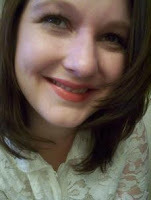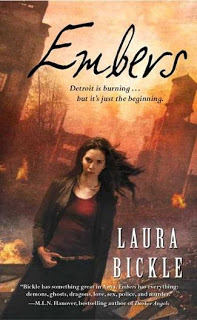Conversations with Ghosts by Laura Bickle
Please click here for the Spring Fling Blog Hop Giveaway!
 I'm very pleased to welcome guest authorLaura Bickleto the blog today!
I'm very pleased to welcome guest authorLaura Bickleto the blog today!Take it away, Laura...
Talking with the dead isn’t a new pursuit.
 I’ve always been curious about how it happens, from both historical and modern perspectives. In my Anya Kalinczyk books, my ghost-hunting protagonist is the rarest form of spiritual medium, a Lantern. Where other mediums in her world allow spirits to use their hanModern ghost hunting involves investigating haunted sites in search of proof of life beyond death. Ghost hunters and other paranormal investigators often attempt to record data from their experiences using a variety of equipment beyond personal anecdotes. Such investigations can make use of EMF meters, thermometers, cameras, motion detectors, and audio recordings to capture evidence of paranormal activity. There’s a plethora of new evidence-collection devices available, with more invented and adapted as time goes on.
I’ve always been curious about how it happens, from both historical and modern perspectives. In my Anya Kalinczyk books, my ghost-hunting protagonist is the rarest form of spiritual medium, a Lantern. Where other mediums in her world allow spirits to use their hanModern ghost hunting involves investigating haunted sites in search of proof of life beyond death. Ghost hunters and other paranormal investigators often attempt to record data from their experiences using a variety of equipment beyond personal anecdotes. Such investigations can make use of EMF meters, thermometers, cameras, motion detectors, and audio recordings to capture evidence of paranormal activity. There’s a plethora of new evidence-collection devices available, with more invented and adapted as time goes on.With all the technology used by ghost hunters and the recent popularity of such investigations, it may seem that such activities are a new phenomenon. In fact, organized attempts to contact ghosts have their roots in Spiritualism, a movement that peaked in popularity between the 1840s and the 1920s. As a belief system, Spiritualism assumed that spirits of the dead could be contacted by humans. Spiritualism relied on mediums, living people who have the special ability to communicate with spirits, to bring the words and deeds of the dead to the masses.
In 1848, two sisters, Kate and Margaret Fox, claimed to contact spirits through rapping noises. The experience of rapping by their audiences was considered to be vivid evidence at the time. Their experiences and the experiences of other mediums in the movement sparked widespread public interest in the afterlife. Seances, table-tipping, Ouija boards, and automatic writing became popular entertainment, even parlor games at parties. Communication with the dead became democratized, in a sense. It could be witnessed by ordinary people.
The movement began to wane under accusations of fraud. In the 1920s, stage magicians such as Harry Houdini campaigned to expose mediums defrauding grieving families. As analysis began to replace belief, many efforts to contact spirits were exposed as delusional or predatory.
Still, the interest in life after death is perennial; across cultures, it‘s a topic for philosophers and theologians. But the Spiritualist movement brought the search to the masses. Ordinary people were able to touch and see evidence of an afterlife for themselves.
 Modern ghost hunters are the heirs of much of those grass-roots efforts. Ghost hunters come from all walks of life, and are ordinary people with an interest in the afterlife. But we now live in a scientific age. Armed with technological tools, many ghost hunters depart from Spiritualists by embracing skepticism, rather than blind belief in things that go bump in the dark. By embracing scientific methods, such investigators are likely to come closer to the truth than the Spiritualists that came before.
Modern ghost hunters are the heirs of much of those grass-roots efforts. Ghost hunters come from all walks of life, and are ordinary people with an interest in the afterlife. But we now live in a scientific age. Armed with technological tools, many ghost hunters depart from Spiritualists by embracing skepticism, rather than blind belief in things that go bump in the dark. By embracing scientific methods, such investigators are likely to come closer to the truth than the Spiritualists that came before.The curiosity is the same, but the methods have changed. Rather than seeing contacting spirits as a game, modern ghost hunting views contact with the dead as an investigation, worthy of measurement and accumulation of evidence, not as a form of entertainment. As a result, we may come closer to answers, answers that curious people a century before could only speculate about.
Oooh, so interesting! Hey, guys, do you have any good ghost stories from your own life? If so, do tell! And please thank Laura for such an intriguing post!
Thanks for reading!Laura & Laura
Read excerpts of Embers and SparksEMBERS is available from Amazon and Barnes & NobleSPARKS is available from Amazon and Barnes & Noble
Published on April 26, 2012 00:00
No comments have been added yet.



